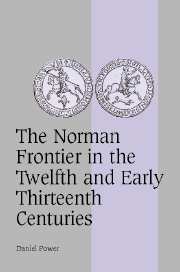Book contents
- Frontmatter
- Contents
- List of maps
- List of tables
- Preface
- Notes on names, dates, manuscripts and coinage
- Note on maps
- List of abbreviations
- Introduction
- Part I PRINCELY POWER AND THE NORMAN FRONTIER
- Part II THE POLITICAL COMMUNITIES OF THE NORMAN FRONTIER
- Part III THE POLITICAL DEVELOPMENT OF THE NORMAN FRONTIER
- Chapter 9 The structure of politics on the Norman frontier
- Chapter 10 The Norman marches in the reign of Henry I (1106–35)
- Chapter 11 The Norman frontier and the Angevin dukes (1135–93)
- Chapter 12 The Norman frontier and the fall of Angevin Normandy (1193–1204)
- Chapter 13 The Norman frontier after 1204
- Conclusion
- Appendix I Genealogies
- Appendix II The campaigns in eastern Normandy (1202)
- Bibliography
- Index
Chapter 13 - The Norman frontier after 1204
Published online by Cambridge University Press: 22 September 2009
- Frontmatter
- Contents
- List of maps
- List of tables
- Preface
- Notes on names, dates, manuscripts and coinage
- Note on maps
- List of abbreviations
- Introduction
- Part I PRINCELY POWER AND THE NORMAN FRONTIER
- Part II THE POLITICAL COMMUNITIES OF THE NORMAN FRONTIER
- Part III THE POLITICAL DEVELOPMENT OF THE NORMAN FRONTIER
- Chapter 9 The structure of politics on the Norman frontier
- Chapter 10 The Norman marches in the reign of Henry I (1106–35)
- Chapter 11 The Norman frontier and the Angevin dukes (1135–93)
- Chapter 12 The Norman frontier and the fall of Angevin Normandy (1193–1204)
- Chapter 13 The Norman frontier after 1204
- Conclusion
- Appendix I Genealogies
- Appendix II The campaigns in eastern Normandy (1202)
- Bibliography
- Index
Summary
With the overthrow of the ducal régime, the Norman frontier defences lost their raison d'être. No longer did the ruler of Normandy require a heavily fortified frontier from Eu to Moulins-la-Marche. Yet just as the fall of the princes of Gwynedd in 1283 would not automatically spell the end of the Welsh marcher lordships, the end of Angevin Normandy did not mean that the whole frontier region lost its marcher character. New jurisdictions did emerge later in the thirteenth century, superseding some of the seigneurial structures of the ducal period, as the counties of Maine, Evreux and Alençon (the latter held in conjunction with a truncated county of Perche) were reconstituted as Capetian apanages. Nevertheless, even in Froissart's day the ‘march of Normandy’ was a well-known feature of the political landscape.
The surrender of Rouen, Verneuil and Arques on 24 June 1204 signalled an end to the chronic frontier warfare that had characterised the Norman marches. It is true that until 1215 there was a serious danger that King John might return to Normandy to revive ducal rule there. In 1205 and 1206 King Philip and his French garrisons in Normandy expected an invasion from England. In 1205, Roger de Mortemer actually made an attempt to revive King John's cause at Dieppe, a port which, along with Fécamp and the ports at the mouth of the Seine, suffered from further hostilities in 1213.
- Type
- Chapter
- Information
- Publisher: Cambridge University PressPrint publication year: 2004



